The Best Cars up for Grabs at Mecum Kissimmee 2024
Mecum’s annual sale in Kissimmee, Florida, is both the world’s largest collector-car auction and typically the very first sale on the calendar. In addition to moving a lot of metal, this two-week extravaganza helps set market moods for the rest of the year. It’s more than 60 acres of automotive spectacle, with multiple buildings and tent after tent protecting the thousands of auction vehicles from the Florida sunshine and occasional rain. Even if you didn’t bring your checkbook, Kissimmee is worth the trip for the car-spotting alone.
Mecum is celebrating the auction’s 25th anniversary in 2024. In both 2022 and 2023, the sale topped $200M. Though it remains to be seen whether that will happen again this year, the consignment list is certainly full (Mecum is claiming nearly 4000 cars) and full of good stuff, too. Below are the most significant cars we’ll be keeping an eye on.
1970 Plymouth Hemi Cuda Convertible
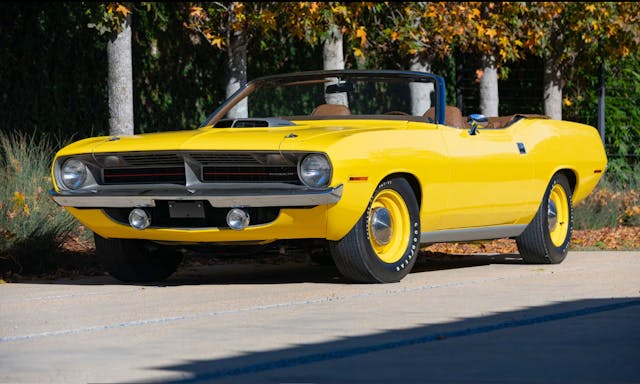
Rarity is a relative term in the classic car world, especially in American muscle cars. A couple hundred units might be a pretty good run for a 1960s Maserati, but for a particular pony-car configuration, “a couple hundred” is supremely scarce. A Hemi Cuda convertible, though, is rare by anybody’s definition. Plymouth sold just 14 of the soft-top Hemis in 1970, and just a dozen in ’71. There aren’t many American muscle cars worth seven figures, but a Hemi Cuda convertible is one of them.
Values have had their ups and downs, and this Lemon Twist car sold at Mecum Indy in 2019 for $1.98M before heading to Kissimmee in 2022, where it remained unsold at a $2.1M high bid. Even so, Mecum has a higher $2.5M–$3.0M estimate this time around.
1963 Ferrari 250 GT SWB California Spider

As a short wheelbase (SWB) California Spider with covered headlights, this car is widely considered the most attractive version in a universally attractive series of cars (there are long-wheelbase and open-headlight cars—all are gorgeous) and finished in the classic combo of red over tan.
It’s represented as the very last of the 106 total 250 GT California Spiders built from 1957 to ’63, and according to online Ferrari resource barchetta, it was delivered in red over black. The car stayed with its original Minnesota owner until 1972 before selling to a Californian who paid $4500 (!) for the used, nine-year-old convertible. Eventually restored from 1999 to 2001 and shown extensively since at prestigious concours like Pebble Beach and Amelia Island, it doesn’t have a presale estimate, but an eight-figure high bid is pretty much a guarantee. Our current values range from $12.95M to $17.1M.
1967 Ferrari 275 GTS/4 NART Spider

An even rarer open-air classic than that Holy Grail Hemi Cuda is this NART Spider. While 25 NART Spiders were planned, just ten genuine cars were ever built. One raced successfully at Sebring and one co-starred with Steve McQueen in The Thomas Crown Affair. This particular NART is the ninth one made.
Sort of a spiritual successor to the California Spider above, this drop-top version of the 275 GTB/4 was made possible by New York Ferrari dealer and owner of the North American Racing Team (NART) Luigi Chinetti, who commissioned the cars with his wealthy clients in mind. Road & Track called it “the most satisfying sports car in the world” and featured it on the cover, but when a hardtop 275 GTB cost less than 10 grand, the Spider’s $14,400 price was steep even for the bigwigs in Chinetti’s Rolodex.
NART Spiders have only gotten more expensive, however. The last NART to sell at auction was in 2013, when chassis 10709 sold for $27.5M. This Kissimmee car, chassis 10749, reportedly sold to the consignor on the private market in 2014 for $28M.
Harley Earl (1963) and Bill Mitchell (1964) Chevrolet Corvette “Styling Cars”
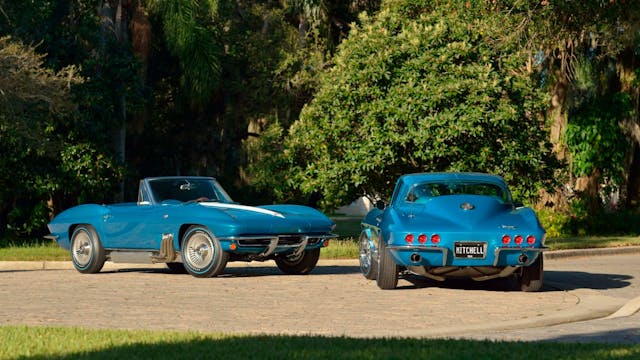
Other than Zora Arkus-Duntov, the two biggest names in the history of the Corvette are designers Harley Earl and Bill Mitchell. These two “Styling Cars” not only had famous designers as owners, they also came packed with unique features.
GM gave Earl the 1963 car as a retirement present, and he reportedly drove it regularly around Palm Beach in his golden years, even lapping Daytona in it in 1965 when he served as Grand Marshal of that year’s 500. Its metallic blue paint wasn’t available in the showrooms in ’63, and neither were the dual-circuit four-wheel disc brakes—those didn’t arrive until 1964. The passenger’s side gauge cluster with altimeter, accelerometer, and two thermometers is a neat touch, as are the four-branch, polished stainless-steel side pipes. The only thing ordinary about the car is the mid-range 327-cubic inch/300-horse small-block, but at least it’s backed by a four-speed manual. Barrett-Jackson sold it in 1999 for $152,300, then Mecum sold it in 2010 for $980,500 and again in 2013 for $1.65M. Mecum paired it as a single lot with the Bill Mitchell car in 2019, though the pair failed to sell with a high bid of $1.7M. The Earl car has a $750,000–$1,000,000 estimate this time around.
Speaking of Bill Mitchell, he was GM’s design boss when the C2 Corvette came to life in 1963, and since being the boss has its perks, he had a 1964 Corvette specially built to his liking for personal use. The special flourishes are a little more subtle than Earl’s car, but the 327/365 V-8 is more potent, and Corvette spotters will notice the eggcrate grille, unique chromed centerlock wheels, chromed side vents, and six taillights. Blue leather covers not just the seats but also the dash, glovebox, and door panels. For Kissimmee, it has a $500,000–$600,000 estimate.
First (1967) and last (1969) Chevrolet Corvette L88
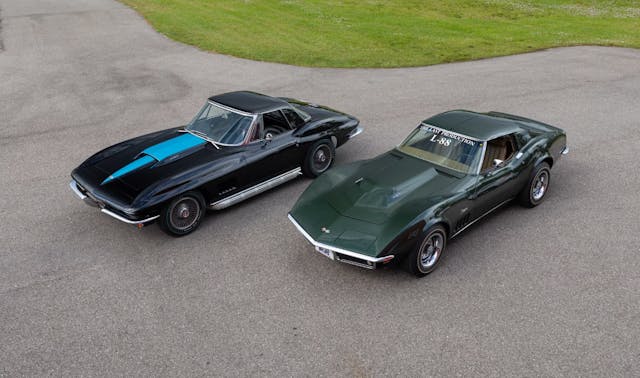
Selling auction cars as a pair is an unusual and somewhat risky move. The entry point is significantly higher, which naturally shrinks the pool of potential bidders. And it takes a very specific kind of buyer who really wants both cars. Auction companies have pulled this off before, however, and Mecum is trying it with this offering of the first and last L88 Corvettes built.
The L88 hardly needs an introduction, but this special-order race-ready package offered from 1967 to ’69 resulted in the fastest and most collectible of all classic production Corvettes. Not that there was much production: Chevrolet built just 20 in 1967, 80 in 1968, and 116 in 1969.
The Tuxedo Black 1967 car is represented as the first production L88, and it was an SCCA race car in 1967–68, finishing second to a 427 Cobra in the 1967 Runoffs. We’ve seen it at auction before—a $1.55M no-sale in 2007, a $1.325M sale in 2010, a $1.7M no-sale in 2019, and a $1.8M no-sale in 2020.
The Fathom Green 1969 car, meanwhile, is comparatively unremarkable other than its build date, but being the bookend for such a famous part of Corvette history counts for a lot. We’ve seen this one before, too. It sold for $242,000 in 2006, was a $235K no-sale in 2012, sold again for $280,500 in 2013, and was a $430,000 no-sale later that year.
1967 Chevrolet Corvette L88 Coupe

For someone who needs just one L88 in their garage, this one-of-20 Rally Red 1967 coupe is still plenty exciting. Maybe more exciting, even. It currently holds the title of most expensive Corvette of any kind ever sold at auction, a status it’s held for nearly a decade. Barrett-Jackson sold it in Scottsdale in 2014 for $3.85M. Setting a new benchmark in 2024 seems unlikely, though. Mecum’s estimate for the car this time around is $3.4M–$3.8M.
1948 Tucker 48
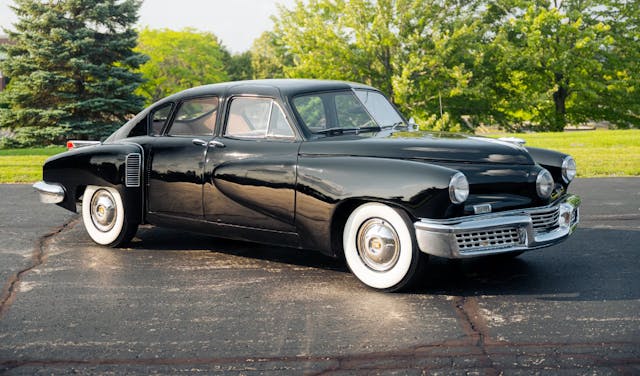
Preston Tucker’s ill-fated automotive venture caused a tsunami of publicity in postwar America, but construction of the actual car—the Tucker 48—amounted to a trickle. Just 51 examples were completed in the former B-29 bomber plant Tucker used for a factory. But thanks to the Hollywood-worthy story and innovative features like a rear-engine layout, directional headlamp, and forward-thinking safety-oriented construction, the Tucker 48 is a well-known and highly valued car.
Only one or two Tuckers pop up for sale per year, if that, and this one has never crossed an auction block. Represented as largely original and as having appeared in the 1988 film about the company, it has a $1.7M–$1.9M estimate.
1990 Porsche 911 Carrera Coupe by Singer

Singer Vehicle Design might be the most well-known and sought-after company when it comes to “reimagining” (read: restomodding) air-cooled 911s. As such, the wait list for one of its bespoke creations is a long one. The only real way to skip the line is to buy one of the few Singers that pop up on the second-hand market. It seems a little odd to open up your wallet for somebody else’s bespoke interpretation of a 911, but other people have paid over $1M at auction for the opportunity, and this 7700-mile car has a $1.2M–$1.3M estimate.
1966 Ford GT40
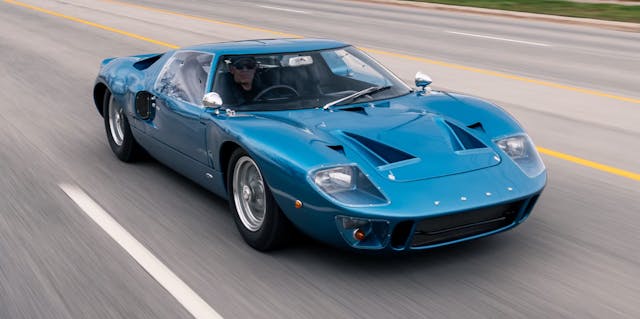
Known for its exploits on track, we usually see the GT40 in multi-colored racing liveries with numbers slapped on its doors. Even rarer than the race cars that got the glory, though, are the 30 GT40 MK Is built for street use. Slightly tamed for normal driving, they came with wire wheels, a nicer interior, and softer suspension.
This one sold new to a buyer in Rome who ordered his Le-Mans-winner-for-the-road with race exhaust and race-spec oil pump. Racing driver Umberto Maglioli bought it in 1968 but it was never raced, and it soon sold on to Germany. RUF, of Porsche modifying fame, eventually treated it to a concours-quality restoration. Though Mecum did not provide an estimate, a Mk I sold at Amelia in 2016 for $3.3M.
1964 Ferrari 275 GTB/LM Competizione Speciale
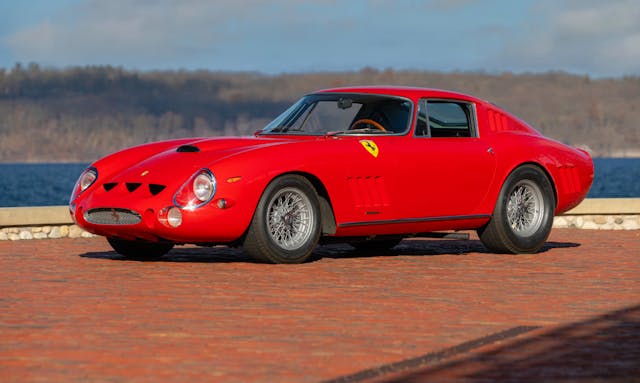
If it sells, this will be the most expensive car in Kissimmee and one of the most expensive cars sold all year. One of three specially built competition versions of the then-new 275 GTB and essentially the successor to the 250 GTO, this is the sister car to the Ferrari that finished third at Le Mans in 1965. This chassis, however, lived its life as a road car, first in Italy and then in France, where it stayed for 25 years. At some point early in its life, it also had three GTO-style nose vents cut into the bodywork. Eventually, the temptation to take it to the track became too strong, and subsequent owners actively vintage-raced it. It has since been restored and last sold at the Monterey auctions in 2014 for $26.4M.
***
Want a better understanding of what’s driving collector car values? Sign up for the Hagerty Insider newsletter.



I have three old cars. A 65, a 73, and a 78. One thing they all have in common. They all ride and drive like old cars. These cars, “up for grabs”, are as interesting as paintings in a museum. Only you don’t need an enclosed trailer to haul a painting. Sorry, but I don’t believe these cars belong in the average garage hobbyist category. I get a much bigger thrill when I see one actually going down the road in my hometown. This auction might as well be a wine tasting event. I wouldn’t watch that either. Come on Hagerty, bring us more barn finds, and less “for millionaire only” cars.
Hagerty maintains that auction exit prices comprise only a small piece of the pie when publishing their car valuation charts. Yet–the Hagerty Literature is FULL of auctions and more auctions! Their Magazine and E-News Literature is rife of auctions. What is the Reader to assume? That auctions are all-important! When the bottom falls out of the collector car market, I would not want to be the one who pushed the importance of auctions and auction values.